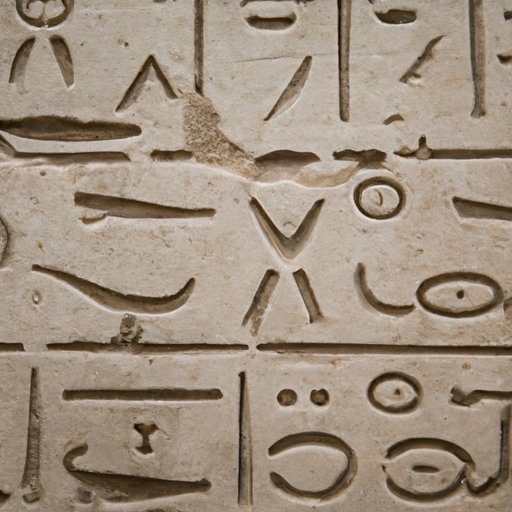Introduction
Ancient Egyptian writing is known as hieroglyphics, which translates to “sacred carvings” in Greek. It is an ancient form of writing that dates back to the early Dynastic Period of Egypt (c. 3150 – c. 2613 BCE). Hieroglyphics were used for a variety of purposes, such as recording events and laws, listing goods, and communicating with gods. This article will explore the history, meaning, and legacy of ancient Egyptian writing.
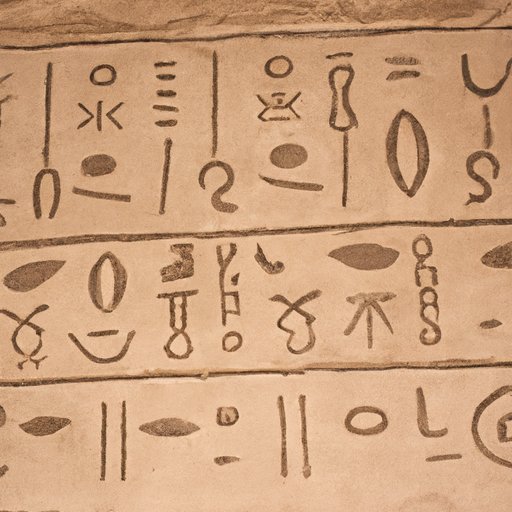
Introducing Hieroglyphics: The Ancient Egyptian Writing System
Hieroglyphics is a writing system composed of pictorial symbols that represent sounds, words, and ideas. The symbols are usually carved into stone or inscribed on papyrus scrolls. Each symbol has a unique meaning and can be combined to form words, sentences, and even entire stories. The earliest examples of hieroglyphic writing date back to the early Dynastic Period of Egypt (c. 3150 – c. 2613 BCE).
The origin of hieroglyphic writing is uncertain, but it is believed to have developed from earlier forms of writing, such as proto-hieroglyphic and hieratic. Scholars believe that the symbols were inspired by pictorial representations of objects, animals, and people. Over time, the symbols evolved into more abstract forms, such as those found in the famous Rosetta Stone.
Examples of hieroglyphic symbols include images of gods and goddesses, animals, plants, tools, buildings, and other objects. They can also represent actions, emotions, and abstract concepts. For example, a man holding an axe could represent strength, while a bird carrying an ankh could represent life.
Unravelling the Mystery of Ancient Egyptian Writing
Hieroglyphics were used for a variety of purposes in ancient Egypt. They were used to record laws, list goods, and communicate with gods. They could also be used to express thoughts and feelings, tell stories, and document historical events. In addition, they were often used in tomb walls and sarcophagi to provide instructions for the afterlife.
To understand the context of hieroglyphic symbols, it is important to consider the context in which they were used. For example, symbols depicting gods and goddesses were often used to invoke their power, while symbols of animals were used to represent certain qualities or characteristics. Similarly, symbols of plants and objects could represent ideas or concepts.
There are many theories about the meaning of hieroglyphic symbols. Some scholars believe that the symbols were used to convey religious beliefs and teachings, while others believe that they were used to encode secret messages. Still others believe that the symbols were simply decorative and meant to be aesthetically pleasing.
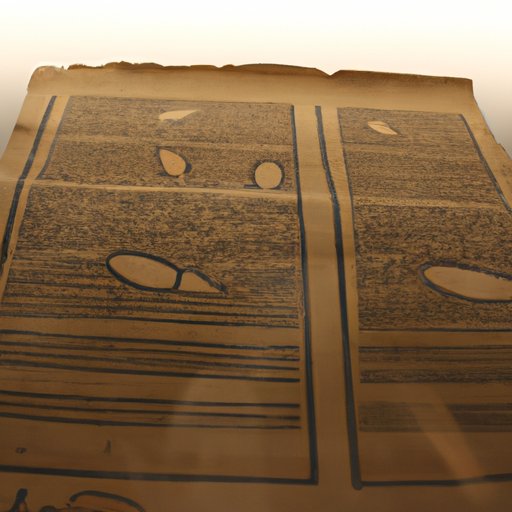
A Brief History of Ancient Egyptian Writing
Hieroglyphic writing developed over a long period of time. By the Old Kingdom (c. 2613 – c. 2181 BCE), hieroglyphics had become a well-developed writing system. During this period, the writing system was simplified and standardized, making it easier to read and write. By the Middle Kingdom (c. 2055 – c. 1650 BCE), hieroglyphic writing had become even more elaborate, with new symbols being added to the existing ones.
Throughout its history, there were several different types of hieroglyphic writing. The most common type was called “hieratic”, which was used for everyday writing. There was also a more stylized version called “demotic”, which was used mainly for religious texts. Finally, there was the hieroglyphic writing used for inscriptions on monuments and tombs.
Exploring the Ancient Art of Hieroglyphic Writing
Hieroglyphic writing was a complex process that required skill and precision. To create a hieroglyphic symbol, a scribe would first draw an outline of the symbol on a piece of papyrus or stone. Then, they would use a chisel or brush to carve or paint the symbol. The symbols were usually painted in black or red ink, but they could also be painted in gold or other colors.
The meaning behind hieroglyphic carvings was often determined by the context in which they were used. For example, a symbol of a falcon could represent royalty or power, while a symbol of a cobra could represent protection. Symbols could also be combined to create more complex meanings, such as when two symbols were combined to form the word “life”.
Creating hieroglyphic symbols was a laborious process, and the scribes used a variety of tools to do so. These tools included brushes, chisels, and mallets. In some cases, the symbols were painted directly onto the surface, while in other cases they were carved into the surface.
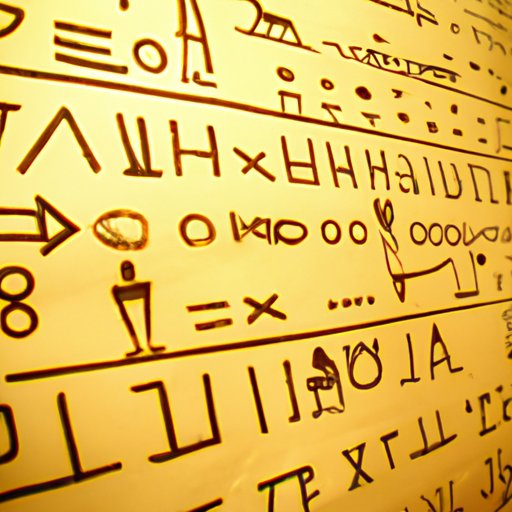
Deciphering the Meaning Behind Egyptian Hieroglyphics
The meaning behind hieroglyphic symbols is still largely a mystery. However, experts have studied the symbols and have been able to uncover some common themes. For example, many hieroglyphic symbols depict gods, goddesses, animals, plants, and objects. Other symbols represent abstract concepts such as love, justice, and truth.
Experts have also been able to decipher the meaning of hieroglyphic symbols by studying the context in which they were used. For example, symbols of gods and goddesses were often used to invoke their power, while symbols of animals were used to represent certain qualities or characteristics. Similarly, symbols of plants and objects could represent ideas or concepts.
Through the study of hieroglyphic symbols, researchers have been able to gain insight into the beliefs and values of the ancient Egyptians. For example, the symbols reveal that the ancient Egyptians had a deep respect for nature, believed in the power of gods and goddesses, and valued justice and truth.
Unlocking the Secrets of Egyptian Hieroglyphs
The decipherment of hieroglyphic symbols has allowed researchers to make some important discoveries. Through hieroglyphic research, scholars have been able to learn more about the language, culture, and history of the ancient Egyptians. They have also been able to uncover the secrets of the afterlife, such as the rituals and beliefs of the ancient Egyptians.
Egyptologists who have studied hieroglyphs have made some remarkable accomplishments. For example, Jean-François Champollion was able to decipher the meaning of the hieroglyphic symbols on the Rosetta Stone, and Howard Carter was able to unlock the secrets of Tutankhamun’s tomb. These accomplishments have helped researchers gain a better understanding of the ancient Egyptians.
Studying hieroglyphics has not been without its challenges. For example, the symbols are often difficult to decipher, and the meaning of some symbols remains a mystery. In addition, some symbols may have multiple meanings, making it difficult to determine their exact meaning.
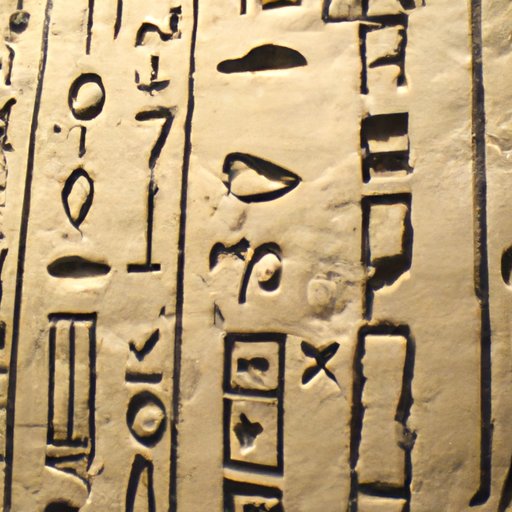
Ancient Egyptian Writing: An Overview of the Hieroglyphic Script
Hieroglyphic writing was an integral part of ancient Egyptian society. It was used to record laws, list goods, and communicate with gods. It was also used to express thoughts and feelings, tell stories, and document historical events. Despite its complexity, hieroglyphic writing has left a lasting legacy.
Today, hieroglyphic writing is still studied by scholars and enthusiasts alike. There are a variety of resources available for those interested in learning more about the history and meaning of hieroglyphic writing. From books and websites to museums and tours, there are plenty of ways to explore the ancient art of hieroglyphic writing.
Conclusion
Hieroglyphic writing was an important part of ancient Egyptian culture. It was used for a variety of purposes, from recording laws and listing goods to communicating with gods and expressing thoughts and feelings. Through the decipherment of hieroglyphic symbols, experts have been able to gain insight into the language, culture, and beliefs of the ancient Egyptians. Today, hieroglyphic writing is still studied by scholars and enthusiasts alike, and its legacy lives on.
(Note: Is this article not meeting your expectations? Do you have knowledge or insights to share? Unlock new opportunities and expand your reach by joining our authors team. Click Registration to join us and share your expertise with our readers.)
